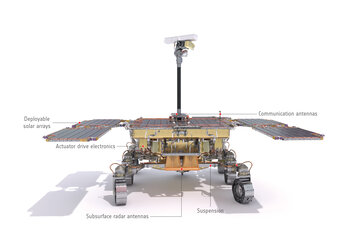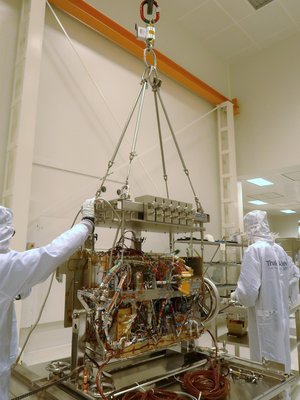Accept all cookies Accept only essential cookies See our Cookie Notice

About ESA
The European Space Agency (ESA) is Europe’s gateway to space. Its mission is to shape the development of Europe’s space capability and ensure that investment in space continues to deliver benefits to the citizens of Europe and the world.
Highlights
ESA - United space in Europe
This is ESA ESA facts Member States & Cooperating States Funding Director General Top management For Member State Delegations European vision European Space Policy ESA & EU Space Councils Responsibility & Sustainability Annual Report Calendar of meetings Corporate newsEstablishments & sites
ESA Headquarters ESA ESTEC ESA ESOC ESA ESRIN ESA EAC ESA ESAC Europe's Spaceport ESA ESEC ESA ECSAT Brussels Office Washington OfficeWorking with ESA
Business with ESA ESA Commercialisation Gateway Law at ESA Careers Cyber resilience at ESA IT at ESA Newsroom Partnerships Merchandising Licence Education Open Space Innovation Platform Integrity and Reporting Administrative Tribunal Health and SafetyMore about ESA
History ESA Historical Archives Exhibitions Publications Art & Culture ESA Merchandise Kids Diversity ESA Brand Centre ESA ChampionsLatest
Space in Member States
Find out more about space activities in our 23 Member States, and understand how ESA works together with their national agencies, institutions and organisations.
Science & Exploration
Exploring our Solar System and unlocking the secrets of the Universe
Go to topicAstronauts
Missions
Juice Euclid Webb Solar Orbiter BepiColombo Gaia ExoMars Cheops Exoplanet missions More missionsActivities
International Space Station Orion service module Gateway Concordia Caves & Pangaea BenefitsLatest
Space Safety
Protecting life and infrastructure on Earth and in orbit
Go to topicAsteroids
Asteroids and Planetary Defence Asteroid danger explained Flyeye telescope: asteroid detection Hera mission: asteroid deflection Near-Earth Object Coordination CentreSpace junk
About space debris Space debris by the numbers Space Environment Report In space refuelling, refurbishing and removingSafety from space
Clean Space ecodesign Zero Debris Technologies Space for Earth Supporting Sustainable DevelopmentLatest
Applications
Using space to benefit citizens and meet future challenges on Earth
Go to topicObserving the Earth
Observing the Earth Future EO Copernicus Meteorology Space for our climate Satellite missionsCommercialisation
ESA Commercialisation Gateway Open Space Innovation Platform Business Incubation ESA Space SolutionsLatest
Enabling & Support
Making space accessible and developing the technologies for the future
Go to topicBuilding missions
Space Engineering and Technology Test centre Laboratories Concurrent Design Facility Preparing for the future Shaping the Future Discovery and Preparation Advanced Concepts TeamSpace transportation
Space Transportation Ariane Vega Space Rider Future space transportation Boost! Europe's Spaceport Launches from Europe's Spaceport from 2012Latest

Laser upgrade for Mars rover
Thank you for liking
You have already liked this page, you can only like it once!
After some time off the road, vehicles require proper maintenance checks. The ExoMars Rosalind Franklin rover is no exception and got an upgrade to one of its electronic boxes in preparation for the long journey to the Red Planet. The mission is scheduled for launch in 2028.
Several years of disuse can lead to failures and increase risks. To ensure peak performance on Mars, the space mechanics diligently replaced certain components of the Raman Laser Spectrometer (RLS), the first instrument of the rover to be refurbished. The delivery took place in an ultra-clean room at premises of ExoMars' prime contractor Thales Alenia Space in Turin, Italy, where it will be reintegrated into the rover later this year.
Rosalind’s spectrometer has the task of studying martian mineralogy using Raman spectroscopy, a well-known laboratory technique on Earth. The instrument will help identify organic compounds and search for microbial life by analysing samples from beneath the martian surface, which will be crushed and reduced to powder.
The replaced box controls all the instrument systems and manages communication with the rover. The upgrade ensures that the laser remains in focus and facilitates the collection of photons for spectral analysis.
The IRAP institute in France spent four months upgrading the one-kilogram box, conducting vibration and thermal vacuum tests. The RLS instrument was jointly developed by INTA in Spain and IRAP.
The components were thoroughly decontaminated through multiple cleaning cycles to prevent microbiological contamination on Mars. The ExoMars Rosalind Franklin rover was built in a biologically controlled cleanroom according to strict planetary protection protocols.
For the latest news about the Rosalind Franklin rover, visit ESA’s ExoMars website and the blog To Mars and Back.
-
CREDIT
IRAP/INTA/ESA -
LICENCE
ESA Standard Licence and Additional permission may be required
(contact spaceinimages@esa.int for further information)

ExoMars Rosalind Franklin rover

ExoMars rover comes out of the ‘oven’

ESA rovers including ExoMars Rosalind Franklin at th…

Rear view of the ExoMars rover















 Germany
Germany
 Austria
Austria
 Belgium
Belgium
 Denmark
Denmark
 Spain
Spain
 Estonia
Estonia
 Finland
Finland
 France
France
 Greece
Greece
 Hungary
Hungary
 Ireland
Ireland
 Italy
Italy
 Luxembourg
Luxembourg
 Norway
Norway
 The Netherlands
The Netherlands
 Poland
Poland
 Portugal
Portugal
 Czechia
Czechia
 Romania
Romania
 United Kingdom
United Kingdom
 Slovenia
Slovenia
 Sweden
Sweden
 Switzerland
Switzerland

























